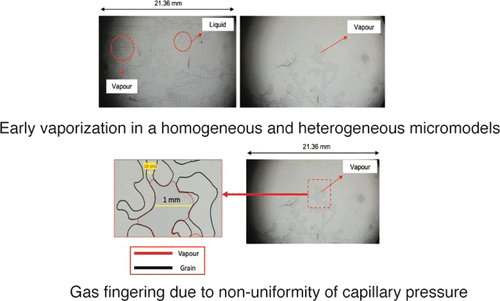当前位置:
X-MOL 学术
›
ACS Appl. Mater. Interfaces
›
论文详情
Our official English website, www.x-mol.net, welcomes your
feedback! (Note: you will need to create a separate account there.)
Propagation and Entrapment of Hydrocarbons in Porous Media under Capillarity Controlled Phase-Alteration Conditions: A Visual Microfluidics Analysis
ACS Applied Materials & Interfaces ( IF 8.3 ) Pub Date : 2021-06-07 , DOI: 10.1021/acsami.1c05503 Ilyas Al-Kindi 1 , Tayfun Babadagli 1
ACS Applied Materials & Interfaces ( IF 8.3 ) Pub Date : 2021-06-07 , DOI: 10.1021/acsami.1c05503 Ilyas Al-Kindi 1 , Tayfun Babadagli 1
Affiliation

|
The displacement characteristics of gas–liquid systems in capillary media under nonisothermal and nonisobaric conditions are controlled by capillarity as phase alteration (specifically vaporization) starts earlier in smaller (nano)capillaries compared to the larger ones. For an accurate modeling of these types of natural and engineered processes, this thermodynamically dictated displacement process should be well understood. With this aim, the capillarity effect on phase change and the displacement dynamics of hydrocarbon liquids in homogeneous and heterogenous silicate microfluidics chips was studied. It was observed that the boiling temperatures of pentane, a pentane–heptane mixture, and a pentane–heptane–octane mixture were 1.6–6.9% lower than bulk measurements due to confinement effects, and the early vaporization had a significant influence on the vapor displacement process. In homogeneous (uniform capillary pressure distribution) porous media, the consistency of capillary pressure resulted in a uniform and quicker propagation/displacement of vapor. However, in the media with variable capillary pressure (heterogeneous pore structure), the vapor’s flow tended to take place nonuniformly along the system, thus leading to a major gas fingering and gas-flow restriction. The presence of other—heavier—components (liquid phase) in the porous medium developed an excessive barrier against the vapor’s flow throughout the pore channels that was specifically caused by the viscous forces of the liquids. Moreover, it was observed that the existence of liquids with high boiling points contribute to slowing the vapor propagation of the lighter components, and the gas displacement becomes slower as the density and viscosity of the liquid-phase components increases.
中文翻译:

毛细管控制相变条件下多孔介质中碳氢化合物的传播和截留:可视化微流体分析
在非等温和非等压条件下毛细管介质中气-液系统的置换特性受毛细管作用控制,因为与较大的毛细管相比,较小(纳米)毛细管中的相变(特别是汽化)开始得更早。为了对这些类型的自然和工程过程进行精确建模,应该很好地理解这种由热力学决定的位移过程。为此,研究了均质和异质硅酸盐微流体芯片中烃类液体的毛细作用对相变和置换动力学的影响。据观察,由于限制效应,戊烷、戊烷-庚烷混合物和戊烷-庚烷-辛烷混合物的沸点温度比本体测量低 1.6-6.9%,早期汽化对蒸汽置换过程有显着影响。在均质(均匀毛细压力分布)多孔介质中,毛细压力的一致性导致蒸汽的均匀和更快的传播/置换。然而,在具有可变毛细管压力(异质孔结构)的介质中,蒸汽的流动往往会沿系统不均匀地发生,从而导致主要的气体指状和气流限制。多孔介质中其他较重的组分(液相)的存在对蒸汽在整个孔隙通道中的流动形成了过多的屏障,这是由液体的粘性力特别引起的。而且,
更新日期:2021-06-16
中文翻译:

毛细管控制相变条件下多孔介质中碳氢化合物的传播和截留:可视化微流体分析
在非等温和非等压条件下毛细管介质中气-液系统的置换特性受毛细管作用控制,因为与较大的毛细管相比,较小(纳米)毛细管中的相变(特别是汽化)开始得更早。为了对这些类型的自然和工程过程进行精确建模,应该很好地理解这种由热力学决定的位移过程。为此,研究了均质和异质硅酸盐微流体芯片中烃类液体的毛细作用对相变和置换动力学的影响。据观察,由于限制效应,戊烷、戊烷-庚烷混合物和戊烷-庚烷-辛烷混合物的沸点温度比本体测量低 1.6-6.9%,早期汽化对蒸汽置换过程有显着影响。在均质(均匀毛细压力分布)多孔介质中,毛细压力的一致性导致蒸汽的均匀和更快的传播/置换。然而,在具有可变毛细管压力(异质孔结构)的介质中,蒸汽的流动往往会沿系统不均匀地发生,从而导致主要的气体指状和气流限制。多孔介质中其他较重的组分(液相)的存在对蒸汽在整个孔隙通道中的流动形成了过多的屏障,这是由液体的粘性力特别引起的。而且,






























 京公网安备 11010802027423号
京公网安备 11010802027423号